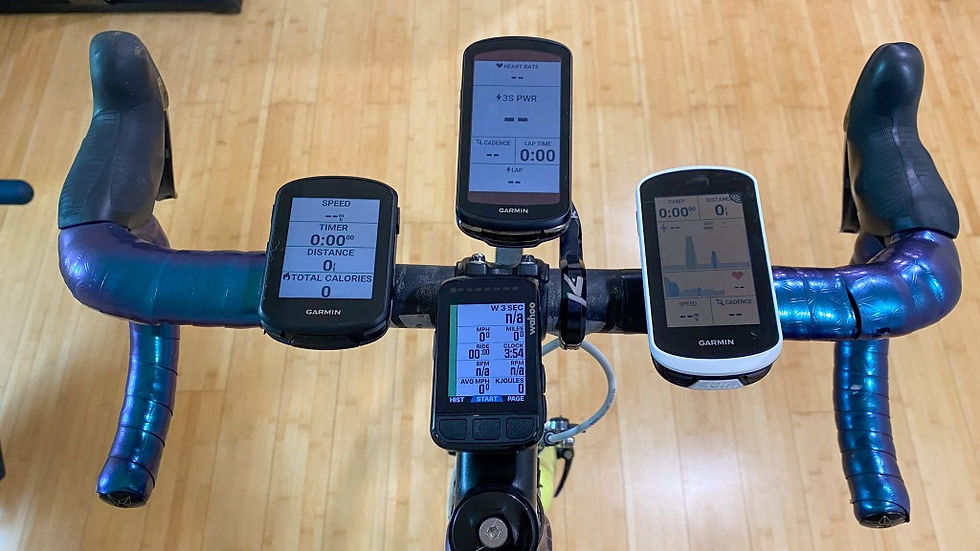Cycling Computers for Every Rider: Beginner to Intermediate Guide.
- Janus van Wyk
- Aug 25
- 4 min read
Updated: Aug 26
One of the most common questions riders and parents ask is:“Is it worth buying a cycling computer, or can I manage without one?”

The short answer: not every rider needs one
immediately — but the right device at the right time can make a big difference.
Cycling computers are more than gadgets. Used properly, they help riders see progress, stay motivated, and give coaches accurate feedback to guide training. Here’s what to know before you buy.
Why Cycling Computers Matter
Motivation: Seeing speed, distance, and ride time keeps riders excited and focused.
Progress Tracking: Devices store and upload data automatically, so nothing gets lost or forgotten.
Coaching Value: Tools like Intervals.icu, Strava, Training Peaks use this data to measure improvement.
The Different Levels
1. Entry-Level (Basic Speedometers)
Measure distance, speed, and ride time only.
Usually the cheapest option.
Not compatible with training platforms like Intervals.icu.
Great for casual fun rides, but limited for structured coaching.
2. Mid-Range (Best for Most Riders)
GPS-based computers (Garmin, Bryton, Wahoo, XOSS).
Support heart rate and cadence sensors.
Sync automatically with apps like Intervals.icu, Strava, and Garmin Connect.
Affordable, reliable, and practical — the sweet spot for most riders who want to train with purpose.
3. High-End (Advanced)
Include navigation, maps, and power meter compatibility.
Only really needed for competitive racing or advanced training.
What About Smartwatches?
If you already own a smartwatch (Garmin, Apple Watch, Polar, Suunto), it can be a good starting point.
✅ They track GPS and heart rate well enough for basic training.
❌ But they can’t connect to cadence or power sensors, and it’s harder to view live data while riding (on your wrist instead of the bars).
💡 If you already have one, use it — but as training gets more structured, a dedicated cycling computer is usually the better long-term solution.

Key Features That Matter
When choosing a cycling computer, here’s what really makes a difference (and what doesn’t):
GPS vs Wheel Sensor:GPS is far more accurate, easier to move between bikes, and doesn’t need fiddly setup. Wheel sensors can still be useful indoors or where GPS signal is weak, but GPS should always be your baseline.
Heart Rate (HR) Sensors:These are essential if you’re training with any kind of structure. They show effort zones, and give context beyond just speed/distance (Coaches can intepret it to see if your sick, overtrained/not training hard enough...)
Cadence Sensors:Tracks pedal speed (RPM). Very useful for younger or newer riders to develop smooth, efficient pedalling habits. Combined with HR data, it gives a much clearer picture of riding style.
Power (Watts):Considered the newest “gold standard” for serious training. Power meters are pricey and usually not needed for beginners — but as riders move into competitive racing, power data becomes the most reliable measure of fitness.
Bluetooth / ANT+ Compatibility:These connections allow your computer to “talk” to sensors (HR, cadence, power) and sync with popular apps like Intervals.icu, Strava, or Garmin Connect. If it doesn’t have Bluetooth/ANT+, it will quickly feel outdated.
Display & Usability:Is the screen easy to read in sunlight? Can you see speed, HR, and distance at a glance while riding? A small but important factor.
Battery Life:Entry-level units often last 6–8 hours. Mid-range and advanced units can go 15–20+. For training camps, long rides or cycling tours, battery life becomes crucial.
Where to Buy
You’ve got a few good options:
1. Online Stores
Takealot, EasyBike, Cycle Lab Online, Sportsmans Warehouse Online.
Often the best prices with regular specials.
Always check warranty and return policies.
2. The Bike Hub (Secondhand Market)
Excellent for bargains or older models.
Ask for proof of purchase, and check battery health and software support.
No warranty, but major savings if you shop carefully.
3. Local Cycling Shops
Usually more expensive, but you can see the device in person.
Staff can help with setup, syncing, and aftersales support.
Best choice if you want peace of mind or aren’t comfortable setting up tech yourself.
Do Riders Really Need One?
Casual or recreational riders → not essential.
Riders following structured training programs → very useful, as it makes tracking, analysis, and progress far more effective.
To give you some perspective from our own rides:
Coach Adele uses a XOSS G2+ (mid-range GPS computer). It tracks speed, distance, heart rate, and cadence, and syncs easily with training apps. For most riders, this level of device is more than enough. The full bundle with sensors will cost around R1,954 on Takealot — a very solid investment without breaking the bank.
Coach Janus rides with a Garmin Edge Explore 2 (high-end GPS computer). It has every fancy feature imaginable — most of which he never actually uses. The equivalent model sells new for around R16,499 at Sportsmans Warehouse, but he bought his secondhand for less then a quarter of the price.
👉 The takeaway? Adele’s mid-range computer is already sufficient for structured training and coaching needs.You don’t need to buy the most expensive device to get real value. And if you do go high-end, secondhand is often the smarter route.
Final Word
A cycling computer isn’t just a gadget — it’s a tool that helps riders at every level ride with purpose and train with precision.
If you’re unsure, start with what you already have (like a smartwatch) and speak to your coach before buying. When the time is right, a mid-range GPS unit with heart rate and cadence support is the best balance of motivation, progress tracking, and long-term value.

Comments